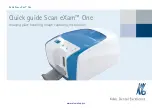
128
Thermo Fisher Scientific
Operation Manual HM550
To cut usable sections, the following points are of utmost importance:
• Condition of the knife edge, probably move it horizontally to the
left or right side.
• Check adjustment of anti-roll guide and correct it, if necessary.
• Carefully remove frost from front and rear part of the knife and
from the anti-roll plate (i.e. with ethanol, acetone or the like).
• Tighten all clamping screws and clamping levers on the knife carrier
and specimen holder.
• Select the appropriate chamber and specimen temperature accord-
ing to the specimen.
Note:
If the specimen was frozen with liquid nitrogen or similar freezing tech-
niques, the specimen must adapt itself to the cutting temperature.
• Carefully select the required knife material and profile.
• Adjustment of knife height.
• Adjustment of proper clearance angle. Select a clearance angle of
8-12° according to the facet angle of a steel knife.
• Select a proper cutting speed:
e harder the material, the slower the cutting speedꢞ
• Take care in bringing specimen and knife together.
• e most protruding point of the specimen must be recognized for
the optimal operation of the automatic approach system.
• e specimen must not be covered at all or too thick by freezing
medium.
• Moreover, for the functionality of the automatic approach system, a
certain conductivity must be given via the specimen chuck as well as
from the knife edge to the microtome base.
For this reason, the original equipment such as knife carrier and
specimen chucks should be used only.
• e specimen clamping of the microtome is connected with a sensi-
tive electronic detecting device. e temperature sensor on the left
side of the microtome housing is also connected with such a device.
Malfunctions might occur after electrostatic discharges on one of
the above-mentioned parts.
How to avoid
malfunctions
Working with the cryostat
How to avoid malfunctions
















































